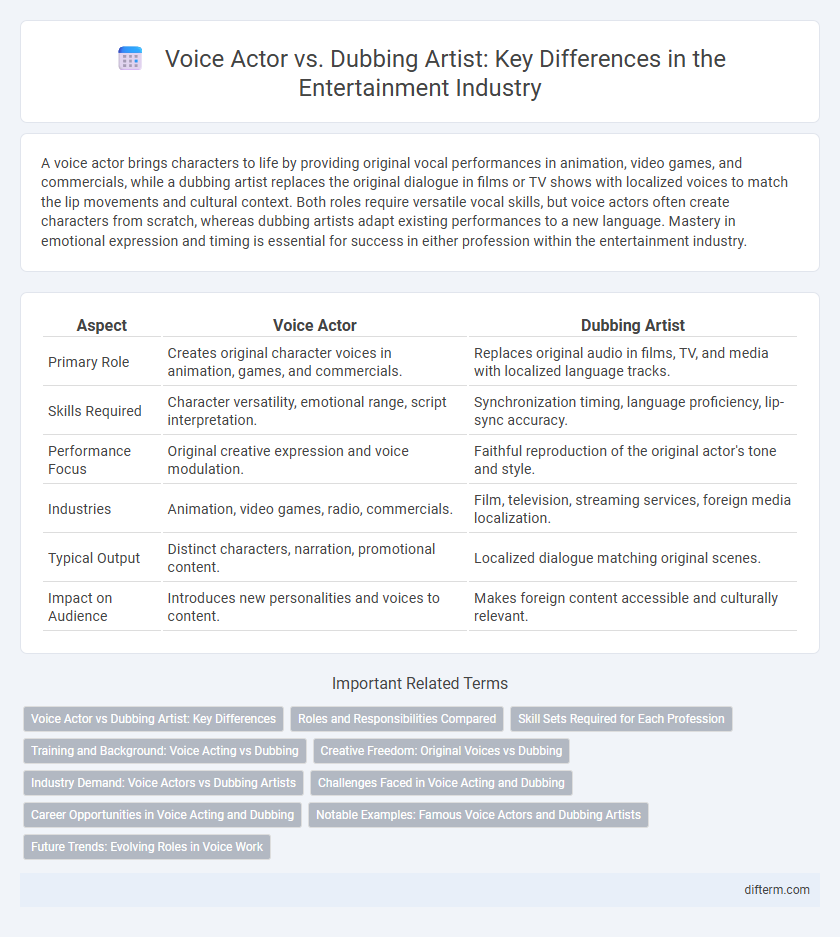A voice actor brings characters to life by providing original vocal performances in animation, video games, and commercials, while a dubbing artist replaces the original dialogue in films or TV shows with localized voices to match the lip movements and cultural context. Both roles require versatile vocal skills, but voice actors often create characters from scratch, whereas dubbing artists adapt existing performances to a new language. Mastery in emotional expression and timing is essential for success in either profession within the entertainment industry.
Table of Comparison
| Aspect | Voice Actor | Dubbing Artist |
|---|---|---|
| Primary Role | Creates original character voices in animation, games, and commercials. | Replaces original audio in films, TV, and media with localized language tracks. |
| Skills Required | Character versatility, emotional range, script interpretation. | Synchronization timing, language proficiency, lip-sync accuracy. |
| Performance Focus | Original creative expression and voice modulation. | Faithful reproduction of the original actor's tone and style. |
| Industries | Animation, video games, radio, commercials. | Film, television, streaming services, foreign media localization. |
| Typical Output | Distinct characters, narration, promotional content. | Localized dialogue matching original scenes. |
| Impact on Audience | Introduces new personalities and voices to content. | Makes foreign content accessible and culturally relevant. |
Voice Actor vs Dubbing Artist: Key Differences
Voice actors create original character voices for animations, video games, and commercials, often requiring a wide emotional range and vocal versatility. Dubbing artists specialize in replacing the original dialogue of foreign films or TV shows with localized voiceovers, maintaining lip-sync accuracy and cultural relevance. Both roles demand vocal precision, but voice actors focus on character creation, while dubbing artists emphasize translation and synchronization.
Roles and Responsibilities Compared
Voice actors bring original characters to life by providing unique vocal performances tailored to the script and character personality, often in animation, video games, or commercials. Dubbing artists specialize in replacing the original dialogue in foreign films or shows, matching lip movements and emotional tone to adapt content for new audiences. Both roles demand vocal versatility and emotional expression, but dubbing requires precise synchronization with existing visuals.
Skill Sets Required for Each Profession
Voice actors excel in creating distinct character voices, emotional expression, and timing to bring scripts to life, often requiring versatility across various genres. Dubbing artists specialize in lip synchronization, matching the original actor's voice tone, and cultural adaptation to maintain authenticity in translated content. Both professions demand strong vocal control and acting skills, but dubbing artists place a heavier emphasis on precision and linguistic proficiency.
Training and Background: Voice Acting vs Dubbing
Voice actors typically undergo specialized training in vocal techniques, character development, and emotional expression to create original performances from scripts. Dubbing artists require expertise in lip-syncing, timing, and matching the original actor's tone, often complemented by language proficiency and cultural adaptation skills. Both professions demand rigorous vocal control and the ability to convey nuanced emotions, but dubbing emphasizes precision alignment with pre-existing video content.
Creative Freedom: Original Voices vs Dubbing
Original voice actors exercise greater creative freedom by crafting unique character expressions and emotional nuances tailored to the script, often influencing the character's identity. Dubbing artists recreate these performances to match lip movements and cultural context, which can limit spontaneity and artistic interpretation. This distinction highlights the original voice actor's role as an originator of vocal emotion versus the dubbing artist's function as an adaptive translator of existing content.
Industry Demand: Voice Actors vs Dubbing Artists
Voice actors and dubbing artists both play crucial roles in the entertainment industry, with voice actors often in higher demand for original animated content, commercials, and video games requiring diverse vocal talents. Dubbing artists are equally essential for localizing international films and TV shows, ensuring cultural nuances and lip-sync accuracy, which drives steady demand in global markets. The rise of streaming platforms and cross-border content consumption continually expands opportunities for both professionals, but voice actors typically have broader role variety and frequency.
Challenges Faced in Voice Acting and Dubbing
Voice actors face challenges such as mastering varied character emotions and maintaining vocal consistency across long recording sessions. Dubbing artists encounter the added difficulty of synchronizing dialogue perfectly with on-screen lip movements while preserving the original performance's emotional tone. Both roles demand adaptability, precise timing, and expert vocal control to deliver authentic and engaging audio experiences.
Career Opportunities in Voice Acting and Dubbing
Voice actors and dubbing artists both offer diverse career opportunities in animation, video games, commercials, and film localization. Voice actors often specialize in creating original character voices and work on projects requiring unique vocal performances, while dubbing artists focus on synchronizing translated audio with existing video content for global markets. Expanding demand for multilingual content and streaming platforms enhances job prospects in both fields, driven by the growing entertainment industry worldwide.
Notable Examples: Famous Voice Actors and Dubbing Artists
Notable voice actors like Mark Hamill and Tara Strong have gained fame for their original character portrayals in animation and video games, creating iconic voices that define their roles. In contrast, dubbing artists such as Cristina Vee and Antonio Banderas specialize in adapting foreign media for new audiences by providing culturally resonant voice performances. The distinction highlights how voice actors contribute to original content creation, while dubbing artists excel in localization and preserving the emotional impact across languages.
Future Trends: Evolving Roles in Voice Work
Voice actors and dubbing artists are increasingly leveraging AI-driven tools to enhance vocal performance and localization accuracy, shaping the future of entertainment voice work. Real-time translation and adaptive voice modulation technologies are expanding the scope of their roles beyond traditional boundaries, enabling seamless cross-cultural content adaptation. Industry demand is shifting towards versatile professionals who combine acting skills with technical proficiency in voice synthesis and digital audio production.
voice actor vs dubbing artist Infographic

 difterm.com
difterm.com